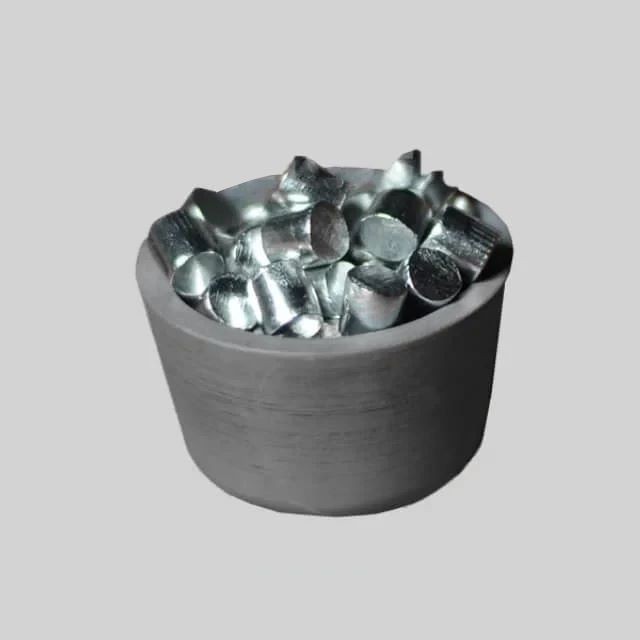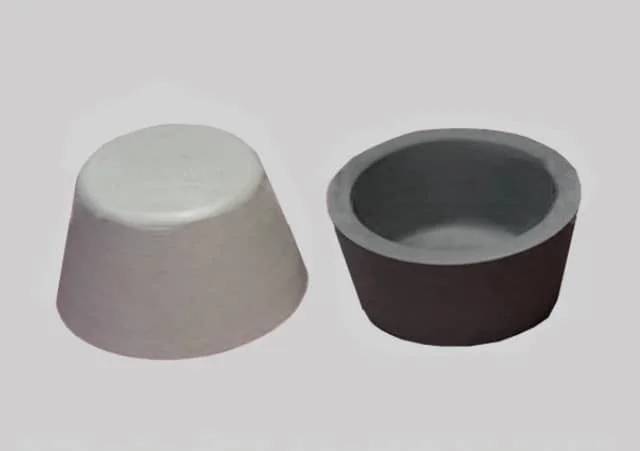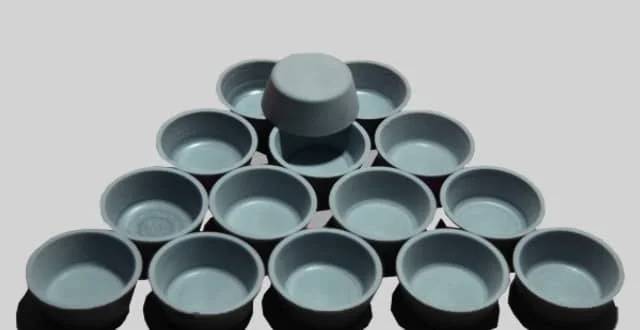
Thin Film Deposition Parts
Electron Beam Evaporation Coating Conductive Boron Nitride Crucible BN Crucible
Item Number : KES03
Price varies based on specs and customizations
- Material
- Boron nitride
- Specification
- 35-64.5mm*17-35mm
Shipping:
Contact us to get shipping details Enjoy On-time Dispatch Guarantee.
Why Choose Us
Easy ordering process, quality products, and dedicated support for your business success.
Application
Conductive boron nitride crucibles are high-purity, smooth crucibles designed for electron beam evaporation coatings. It has excellent high temperature resistance and thermal cycle performance, and does not react with various metals and ceramic rare earths. The crucible remains intact even under rapid heating and cooling conditions. It has applications in alloy melting, rare earth and ceramic sintering, and electron beam evaporation coating. It is often used in thermal evaporation processes such as high-frequency induction heating, coating, electron beam evaporation coating, aluminum plating, and silicon plating.
The conductive boron nitride crucible has high purity, high finish, and excellent electron beam evaporation coating performance. They can increase evaporation rates, accelerate material switching, improve thermal stability and reduce power requirements, ultimately increasing productivity and cost efficiency.
Detail & Parts



Technical Specifications
| Outer diameter | 35mm | 40mm | 45mm | 50mm | 64.5mm |
| High | 17mm | 20mm | 22.5mm | 25mm | 35mm |
The crucibles we show are available in different sizes and custom sizes are available on request.
Advantage
- The film has good finish, high purity, less pollution and long service life.
- Excellent high temperature resistance, heat cycle resistance.
- Low thermal expansion, resists wetting by most molten metals.
- Heat resistance up to 2000℃, boron nitride does not react with aluminum and is not easy to volatilize.
- Increased evaporation rate; Increased evaporation rate reduces cycle time and increases overall yield.
- Fast material changeover; Conductive boron nitride crucibles facilitate fast material changeover, minimizing chamber downtime and increasing process efficiency.
- Enhanced Thermal Stability; These crucibles have increased thermal stability, reducing heat transfer from the crucible itself and ensuring consistent and controlled evaporation.
FAQ
What Are Thermal Evaporation Sources?
What Are The Main Types Of Thermal Evaporation Sources?
How Do Thermal Evaporation Sources Work?
What Are The Common Materials Used For Evaporating Crucibles?
What Are The Advantages Of Using Thermal Evaporation Sources?
What Are The Advantages Of Using Evaporating Crucibles?
What Applications Are Thermal Evaporation Sources Used For?
How Should Evaporating Crucibles Be Handled And Maintained?
4.9 / 5
The boron nitride crucible delivered in 3 days, which is really fast! The quality is excellent and it fits perfectly in my electron beam evaporator.
4.7 / 5
I'm very impressed with the performance of this crucible. It has increased the evaporation rate and reduced the power requirements in my electron beam evaporator.
4.8 / 5
The conductive boron nitride crucible is a great choice for electron beam evaporation coating. It has a long service life and produces high-quality films.
4.6 / 5
I've been using this crucible for several months now and I'm very happy with it. It's very durable and has helped me to improve the quality of my coatings.
4.9 / 5
This crucible is a game-changer! It has significantly improved the efficiency of my electron beam evaporator and reduced my production costs.
4.7 / 5
I highly recommend this crucible to anyone who is looking for a high-quality and durable option for electron beam evaporation coating.
4.8 / 5
The conductive boron nitride crucible is an excellent choice for high-temperature applications. It has excellent thermal stability and resists wetting by most molten metals.
4.6 / 5
I'm very satisfied with this crucible. It has helped me to improve the quality of my coatings and reduce my production costs.
4.9 / 5
This crucible is a must-have for anyone who is serious about electron beam evaporation coating. It's a great value for the price.
4.7 / 5
I'm very impressed with the performance of this crucible. It has exceeded my expectations and I highly recommend it.
4.8 / 5
The conductive boron nitride crucible is a great choice for electron beam evaporation coating. It's easy to use and produces high-quality films.
4.6 / 5
I've been using this crucible for a few weeks now and I'm very happy with it. It's very durable and has helped me to improve the quality of my coatings.
4.9 / 5
This crucible is a game-changer! It has significantly improved the efficiency of my electron beam evaporator and reduced my production costs.
4.7 / 5
I highly recommend this crucible to anyone who is looking for a high-quality and durable option for electron beam evaporation coating.
4.8 / 5
The conductive boron nitride crucible is an excellent choice for high-temperature applications. It has excellent thermal stability and resists wetting by most molten metals.
4.6 / 5
I'm very satisfied with this crucible. It has helped me to improve the quality of my coatings and reduce my production costs.
REQUEST A QUOTE
Our professional team will reply to you within one business day. Please feel free to contact us!
Related Products

E Beam Crucibles Electron Gun Beam Crucible for Evaporation
In the context of electron gun beam evaporation, a crucible is a container or source holder used to contain and evaporate the material to be deposited onto a substrate.

Boron Nitride (BN) Crucible for Phosphorous Powder Sintered
Phosphorus powder sintered boron nitride (BN) crucible has a smooth surface, dense, pollution-free and long service life.

Conductive Boron Nitride BN Ceramics Composite for Advanced Applications
Due to the characteristics of boron nitride itself, the dielectric constant and dielectric loss are very small, so it is an ideal electrical insulating material.

Evaporation Crucible for Organic Matter
An evaporation crucible for organic matter, referred to as an evaporation crucible, is a container for evaporating organic solvents in a laboratory environment.

Advanced Engineering Fine Ceramics Boron Nitride (BN) Ceramic Parts
Boron nitride ((BN) is a compound with high melting point, high hardness, high thermal conductivity and high electrical resistivity. Its crystal structure is similar to graphene and harder than diamond.

Hexagonal Boron Nitride HBN Ceramic Ring
Boron nitride ceramic (BN) rings are commonly used in high temperature applications such as furnace fixtures, heat exchangers and semiconductor processing.

Electron Beam Evaporation Coating Tungsten Crucible and Molybdenum Crucible for High Temperature Applications
Tungsten and molybdenum crucibles are commonly used in electron beam evaporation processes due to their excellent thermal and mechanical properties.

High Purity Pure Graphite Crucible for Electron Beam Evaporation
A technology mainly used in the field of power electronics. It is a graphite film made of carbon source material by material deposition using electron beam technology.

High Purity Pure Graphite Crucible for Evaporation
Vessels for high temperature applications, where materials are kept at extremely high temperatures to evaporate, allowing thin films to be deposited on substrates.

Electron Beam Evaporation Coating Gold Plating Tungsten Molybdenum Crucible for Evaporation
These crucibles act as containers for the gold material evaporated by the electron evaporation beam while precisely directing the electron beam for precise deposition.

Hexagonal Boron Nitride HBN Thermocouple Protection Tube
Hexagonal boron nitride ceramics is an emerging industrial material. Because of its similar structure to graphite and many similarities in performance, it is also called "white graphite".

Electron Beam Evaporation Coating Oxygen-Free Copper Crucible and Evaporation Boat
Electron Beam Evaporation Coating Oxygen-Free Copper Crucible enables precise co-deposition of various materials. Its controlled temperature and water-cooled design ensure pure and efficient thin film deposition.

RRDE rotating disk (ring disk) electrode / compatible with PINE, Japanese ALS, Swiss Metrohm glassy carbon platinum
Elevate your electrochemical research with our Rotating Disk and Ring Electrodes. Corrosion resistant and customizable to your specific needs, with complete specifications.

Tungsten Evaporation Boat for Thin Film Deposition
Learn about tungsten boats, also known as evaporated or coated tungsten boats. With a high tungsten content of 99.95%, these boats are ideal for high-temperature environments and widely used in various industries. Discover their properties and applications here.

Engineering Advanced Fine Alumina Al2O3 Ceramic Crucible for Laboratory Muffle Furnace
Alumina ceramic crucibles are used in some materials and metal melting tools, and flat-bottomed crucibles are suitable for melting and processing larger batches of materials with better stability and uniformity.

Custom CVD Diamond Coating for Lab Applications
CVD Diamond Coating: Superior Thermal Conductivity, Crystal Quality, and Adhesion for Cutting Tools, Friction, and Acoustic Applications
Related Articles

CVD furnace for the growth of carbon nanotubes
Chemical vapor deposition (CVD) furnace technology is a widely used method for growing carbon nanotubes.

Electron Beam Evaporation Coating Technology and Material Selection
An in-depth look at the principles and applications of electron beam evaporation coating technology, including material selection and various fields of application.

Electron Beam Evaporation Coating: Principles, Characteristics, and Applications
An in-depth analysis of electron beam evaporation coating technology, its advantages, disadvantages, and applications in thin film manufacturing.

Comparison of Pyrolytic Graphite and Pyrolytic Boron Nitride Crucibles
A detailed comparison of pyrolytic graphite and pyrolytic boron nitride crucibles, focusing on their preparation processes, characteristics, and applications.

Electron Beam Evaporation Coating: Advantages, Disadvantages, and Applications
An in-depth look at the pros and cons of electron beam evaporation coating and its various applications in industries.

Electron Beam Evaporation Technology in Vacuum Coating
An in-depth look at electron beam evaporation, its types, advantages, and disadvantages in vacuum coating processes.

Guidelines for the Use of Boron Nitride Crucibles
Instructions on the proper use, precautions, and compatibility of boron nitride crucibles.

Introduction to Various Ceramic Crucibles
An overview of different types of ceramic crucibles, their properties, and applications.

Electron Beam Evaporation: Advanced Thin Film Creation
Explores the technology and applications of electron beam evaporation in thin film production.

Understanding Evaporation Boats in Vacuum Coating
An in-depth look at evaporation boats, their materials, arrangement, temperature control, and corrosion issues in vacuum coating processes.

Inorganic Non-Metallic Materials: Crucibles
An overview of crucibles made from various inorganic non-metallic materials, their uses, technical parameters, and advantages.

High Purity Graphite Crucible: Features, Production, and Usage
An in-depth look at high purity graphite crucibles, their production processes, and their industrial applications.